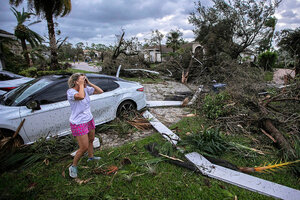After Hurricane Milton: Relief and resilience, but also a shaken Florida

An American flag waves as Hurricane Milton approached in Orlando, Florida, Oct. 9, 2024.
Jose Luis Gonzalez/Reuters
GAINESVILLE, FLA.
Hundreds of thousands of Floridians began returning home Thursday after the second major hurricane within two weeks crashed into the western coast of their state, bringing winds topping 100 mph, multiple feet of storm surge, and the fear of a new era of supercharged extreme weather.
In many ways, the morning also brought a collective sigh of relief. Despite predictions, Hurricane Milton did not flatten either Tampa or St. Petersburg, where it had seemed to be heading directly as of a day ago. And despite human tragedies, including five reported deaths when a tornado hit a retirement community in St. Lucie County, early reports suggested that emergency preparations and evacuations saved lives as the storm crossed the densely populated center of the Florida Peninsula.
“The storm was significant, but thankfully this was not the worst-case scenario,” said Florida Gov. Ron DeSantis at a briefing Thursday morning.
Why We Wrote This
While less devastating than many had feared, Hurricane Milton reflected what many see as growing climate disruption – and the perseverance it will require.
Still, Milton’s strength, the unprecedented number of tornadoes that accompanied it, and its appearance so soon after Hurricane Helene reflect what many see as a new era of climate disruption, fueled by global warming and hotter than normal ocean water. Flash flood warnings remained in effect across the state, more than 3 million residents lost power, and officials warned that the real toll of the storm was yet to be calculated.
On social media and elsewhere, many Floridians registered their fear and exhaustion from back-to-back disasters. But many also doubled down on their dedication to the Sunshine State.
“I would much rather stay here and see my Gulf of Mexico and my marine life and palm trees than anything else in the world,” says Beth Reynolds, a born-and-raised Floridian who stayed in her St. Petersburg home throughout the storm.
Her house was in a mandatory evacuation zone, she explains, but she had recently invested in hurricane-proofing it, installing high-impact windows, hurricane straps, and a new roof. She had filled both her freezer and refrigerator with water bottles, stocked up on snacks, and filled her solar-powered battery chargers.
“I have three dogs and a giant tortoise,” she explains, “which makes it difficult to evacuate.”
Ms. Reynolds has lived up and down the East Coast of the United States, but she keeps returning here, where she is a nature photographer and an active volunteer with local environmental organizations.
“I am just a real salty beach person and I love this area,” she says. “I can’t think of any other place I would want to live.”
On Thursday morning, Ms. Reynolds said she had power and was turning her attention to cleaning up from the storm.
“I have a lot of debris to clean up, but my neighborhood is looking pretty good,” she wrote by text.
Many of her neighbors had evacuated.
For days, as Hurricane Milton moved across the Gulf of Mexico, it seemed to be aiming straight for the densely populated Tampa Bay area, where residents still hadn’t finished cleaning up the wreckage from Hurricane Helene.
Helene was the worst storm Tampa had seen in a century, unleashing up to 7 feet of unexpected storm surge in some waterfront neighborhoods. Less than two weeks later, Milton looked like it could be even more devastating. As the storm approached the Gulf Coast, mandatory evacuation notices spurred many Floridians out of their homes. Bridges across Tampa Bay were thick with traffic. Families in cars packed to the gills shared the roads with trucks bearing loads of debris from Helene.
Meanwhile, federal officials relocated search-and-rescue workers to the region, while the state activated the Florida National Guard.
The storm barreled ashore Wednesday around 8:30 p.m. in Siesta Key, near Sarasota, about 60 miles south of Tampa. That landing point, officials said, resulted in a “reverse surge” in Tampa Bay, in which water levels temporarily dropped, contrary to the predictions of a multifoot increase.
Milton remained at hurricane strength as it rammed through central Florida, dumping heavy rain and causing dangerous inland flooding until it exited the state midmorning at Cape Canaveral. Still, residents along Florida’s east coast and into Georgia remained braced for dangerous storm surges.
The 100 mph winds at Milton’s landfall shredded the roof of Tropicana Field, the iconic ballpark that houses Major League Baseball’s Tampa Bay Rays. Roof panels hung like streamers over the field, which was lined with cots accommodating hundreds of first responders. Downtown, a crane collapsed onto the offices of the Tampa Bay Times and a high-rise condominium, although officials said nobody was harmed in either incident.
Tampa Bay – and central Florida at large – is home to scores of freshly arrived residents. The region’s population surged following the coronavirus pandemic; many of these newcomers had never experienced a hurricane before.
Brit Blackford moved to St. Petersburg a month ago for a new job from Asheville, North Carolina, which was devastated by flooding connected to Hurricane Helene. She lives outside the mandatory evacuation zones, but says she was unsure what to expect from this next, huge storm. Erring on the side of caution, she packed her car and left for a friend’s house in the landlocked city of Lakeland, with her two beagles, pet snake, and parrot in tow.
Originally from Indiana, Ms. Blackford was excited to move to the Tampa Bay area, where her family had vacationed during her childhood. She doesn’t anticipate that these back-to-back storms will change her plans to stay in Florida for the long term. Instead, she says this experience will leave her better prepared for the next time.
“It’s all a learning curve,” she says. “What will the consequence be [from] this learning curve? I’m not sure yet. I’ll find that out as soon as I go home.”


